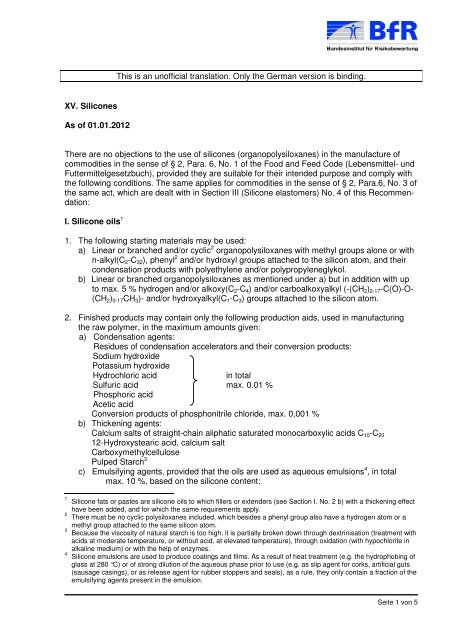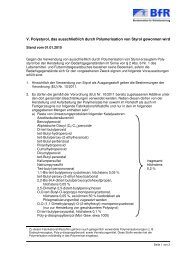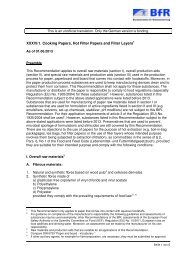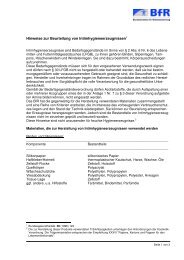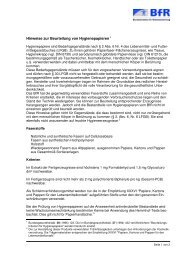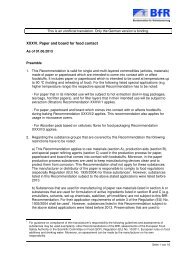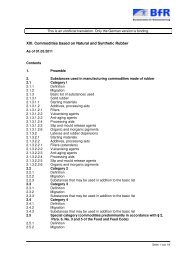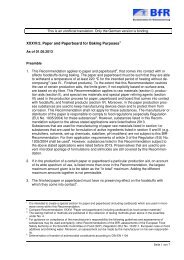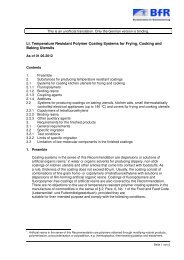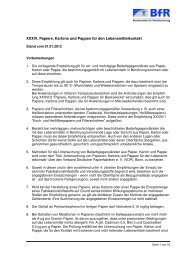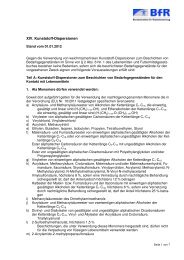This is an unofficial translation. Only the German version is binding ...
This is an unofficial translation. Only the German version is binding ...
This is an unofficial translation. Only the German version is binding ...
Create successful ePaper yourself
Turn your PDF publications into a flip-book with our unique Google optimized e-Paper software.
XV. Silicones<br />
As of 01.01.2012<br />
<strong>Th<strong>is</strong></strong> <strong>is</strong> <strong>an</strong> <strong>unofficial</strong> tr<strong>an</strong>slation. <strong>Only</strong> <strong>the</strong> Germ<strong>an</strong> <strong>version</strong> <strong>is</strong> <strong>binding</strong>.<br />
There are no objections to <strong>the</strong> use of silicones (org<strong>an</strong>opolysilox<strong>an</strong>es) in <strong>the</strong> m<strong>an</strong>ufacture of<br />
commodities in <strong>the</strong> sense of § 2, Para. 6, No. 1 of <strong>the</strong> Food <strong>an</strong>d Feed Code (Lebensmittel- und<br />
Futtermittelgesetzbuch), provided <strong>the</strong>y are suitable for <strong>the</strong>ir intended purpose <strong>an</strong>d comply with<br />
<strong>the</strong> following conditions. The same applies for commodities in <strong>the</strong> sense of § 2, Para.6, No. 3 of<br />
<strong>the</strong> same act, which are dealt with in Section III (Silicone elastomers) No. 4 of th<strong>is</strong> Recommendation:<br />
I. Silicone oils 1<br />
1. The following starting materials may be used:<br />
a) Linear or br<strong>an</strong>ched <strong>an</strong>d/or cyclic 2 org<strong>an</strong>opolysilox<strong>an</strong>es with methyl groups alone or with<br />
n-alkyl(C2-C32), phenyl 2 <strong>an</strong>d/or hydroxyl groups attached to <strong>the</strong> silicon atom, <strong>an</strong>d <strong>the</strong>ir<br />
condensation products with polyethylene <strong>an</strong>d/or polypropyleneglykol.<br />
b) Linear or br<strong>an</strong>ched org<strong>an</strong>opolysilox<strong>an</strong>es as mentioned under a) but in addition with up<br />
to max. 5 % hydrogen <strong>an</strong>d/or alkoxy(C2-C4) <strong>an</strong>d/or carboalkoxyalkyl (-(CH2)2-17-C(O)-O-<br />
(CH2)0-17CH3)- <strong>an</strong>d/or hydroxyalkyl(C1-C3) groups attached to <strong>the</strong> silicon atom.<br />
2. Fin<strong>is</strong>hed products may contain only <strong>the</strong> following production aids, used in m<strong>an</strong>ufacturing<br />
<strong>the</strong> raw polymer, in <strong>the</strong> maximum amounts given:<br />
a) Condensation agents:<br />
Residues of condensation accelerators <strong>an</strong>d <strong>the</strong>ir con<strong>version</strong> products:<br />
Sodium hydroxide<br />
Potassium hydroxide<br />
Hydrochloric acid in total<br />
Sulfuric acid max. 0.01 %<br />
Phosphoric acid<br />
Acetic acid<br />
Con<strong>version</strong> products of phosphonitrile chloride, max. 0,001 %<br />
b) Thickening agents:<br />
Calcium salts of straight-chain aliphatic saturated monocarboxylic acids C10-C20<br />
12-Hydroxystearic acid, calcium salt<br />
Carboxymethylcellulose<br />
Pulped Starch 3<br />
c) Emulsifying agents, provided that <strong>the</strong> oils are used as aqueous emulsions 4 , in total<br />
max. 10 %, based on <strong>the</strong> silicone content:<br />
1<br />
Silicone fats or pastes are silicone oils to which fillers or extenders (see Section I. No. 2 b) with a thickening effect<br />
have been added, <strong>an</strong>d for which <strong>the</strong> same requirements apply.<br />
2<br />
There must be no cyclic polysilox<strong>an</strong>es included, which besides a phenyl group also have a hydrogen atom or a<br />
methyl group attached to <strong>the</strong> same silicon atom.<br />
3<br />
Because <strong>the</strong> v<strong>is</strong>cosity of natural starch <strong>is</strong> too high, it <strong>is</strong> partially broken down through dextrin<strong>is</strong>ation (treatment with<br />
acids at moderate temperature, or without acid, at elevated temperature), through oxidation (with hypochlorite in<br />
alkaline medium) or with <strong>the</strong> help of enzymes.<br />
4<br />
Silicone emulsions are used to produce coatings <strong>an</strong>d films. As a result of heat treatment (e.g. <strong>the</strong> hydrophobing of<br />
glass at 280 °C) or of strong dilution of <strong>the</strong> aqueous phase prior to use (e.g. as slip agent for corks, artificial guts<br />
(sausage casings), or as release agent for rubber stoppers <strong>an</strong>d seals), as a rule, <strong>the</strong>y only contain a fraction of <strong>the</strong><br />
emulsifying agents present in <strong>the</strong> emulsion.<br />
Seite 1 von 5
Federal Institute for R<strong>is</strong>k Assessment<br />
Alkyl(C8-C18) dimethylbenzyl ammonium chloride, max. 1.5 %, but only for coating paper<br />
Sodium dodecyl sulfate, max. 0.5 %<br />
Polyethyleneglycol e<strong>the</strong>rs of monohydric aliphatic alcohols C12-C20 <strong>an</strong>d of C2-C9 alkyl<br />
phenols<br />
Polyethyleneglycol esters of natural fatty acids C8-C22 <strong>an</strong>d vegetable oils<br />
Semi-acetylated polyvinyl alcohol with less th<strong>an</strong> 20 % acetyl groups <strong>an</strong>d a K-value<br />
greater th<strong>an</strong> 40<br />
3. Preserving agents:<br />
The following preserving agents may be added to silicone oil emulsions:<br />
Formaldehyde, max. 0.1 %.<br />
1 ml extract from <strong>the</strong> fin<strong>is</strong>hed products may contain no more th<strong>an</strong> 3 µg formaldehyde 5 .<br />
Sorbic acid, max. 0.1 %.<br />
4. Kinematic v<strong>is</strong>cosity of <strong>the</strong> silicone oils, measured according to DIN 51 562 at 20 °C, must<br />
be min. 100 mm 2 • s -1 .<br />
II. Silicone resins<br />
1. The following starting materials may be used:<br />
Linear <strong>an</strong>d br<strong>an</strong>ched org<strong>an</strong>opolysilox<strong>an</strong>es with methyl groups alone <strong>an</strong>d/or n-alkyl(C2-C32)-,<br />
<strong>an</strong>d/or phenyl- 2 , <strong>an</strong>d/or vinyl-, <strong>an</strong>d/or hydroxyl-, <strong>an</strong>d/or alkoxy(C1-C4)-, <strong>an</strong>d/or hydrogen-,<br />
<strong>an</strong>d/or carboalkoxyalkyl(-(CH2)2-17-C(O)-O-(CH2)0-17CH3)-, <strong>an</strong>d/or hydroxyalkyl(C1-C3)groups<br />
attached to <strong>the</strong> silicon atom also in combination with polycondensation products (esters)<br />
of:<br />
Isophthalic acid<br />
Terephthalic acid<br />
Eth<strong>an</strong>diol<br />
Trimethylol prop<strong>an</strong>e<br />
4,4'-Dioxydiphenyl-2,2-prop<strong>an</strong>e (b<strong>is</strong>phenol A)<br />
Glycerol<br />
Pentaerythrite<br />
2. Fin<strong>is</strong>hed products may contain only <strong>the</strong> following production aids, used in m<strong>an</strong>ufacturing<br />
<strong>an</strong>d processing <strong>the</strong> raw polymer, in <strong>the</strong> maximum amounts given:<br />
a) Condensation agents:<br />
Residues of hydrochloric acid <strong>an</strong>d its con<strong>version</strong> products with fillers <strong>an</strong>d hardeners, in<br />
total max. 0.1 %<br />
b) Hardeners:<br />
α) Zinc-di-2-ethylhexoate in total<br />
Di-n-octyl-tin-maleinate max. 1.5 %<br />
β) Con<strong>version</strong> products 6 of hardeners named under α), plus <strong>the</strong> following:<br />
Butyltit<strong>an</strong>ate <strong>an</strong>d/or butylpolytit<strong>an</strong>ate, as necessary, with <strong>the</strong> monoethyl e<strong>the</strong>r of<br />
eth<strong>an</strong>ediol (ethyleneglycol) in <strong>the</strong> ratio 1:1 7<br />
Aluminium acetylacetonate<br />
Zirconium acetylacetonate<br />
5 st<br />
61 Communication on testing of plastics in Bundesgesundheitsblatt, Gesundheitsforschung, Gesundheitsschutz<br />
46 (2003) 362.<br />
6<br />
The con<strong>version</strong> products are ei<strong>the</strong>r incorporated into <strong>the</strong> resin or occur as oxides. Thus, a qu<strong>an</strong>titative limit <strong>is</strong> not<br />
deemed necessary.<br />
7 To be used at temperatures of at least 180 °C.<br />
Seite 2 von 5
Federal Institute for R<strong>is</strong>k Assessment<br />
c) Emulsifying agents:<br />
In so far as <strong>the</strong> resins are used in <strong>the</strong> form of aqueous emulsions 4 , <strong>the</strong> subst<strong>an</strong>ces l<strong>is</strong>ted<br />
above under 1, No. 2 c may be used, however, max. 7.0 %, based on silicone content.<br />
3. The following subst<strong>an</strong>ces may be added to silicone resins used for coating paper:<br />
Carboxymethyl cellulose<br />
Pulped starch 3<br />
Alginates<br />
Casein<br />
D<strong>is</strong>persions of hard paraffin <strong>an</strong>d wax 8<br />
D<strong>is</strong>persions based on copolymers of acrylic <strong>an</strong>d methacrylic acid esters, butadiene <strong>an</strong>d<br />
styrene, provided <strong>the</strong>y comply with Recommendation XIV 9 .<br />
Polyvinyl alcohol (v<strong>is</strong>cosity of 4 % aqueous solution at 20 °C min. 5 cP).<br />
Hydroxyethyl cellulose, max. 2 % in <strong>the</strong> resin.<br />
III. Silicone elastomers (Silicone rubber)<br />
1. The following starting materials may be used:<br />
Polymers complying with Section I, No.1 of th<strong>is</strong> Recommendation<br />
Org<strong>an</strong>opolysilox<strong>an</strong>es with vinyl groups attached to <strong>the</strong> silicon atom<br />
Addition products of trivinyl cyclohex<strong>an</strong>e <strong>an</strong>d α,ω-Dihydrogenpolyhydrogen-<br />
methyldimethyl-silox<strong>an</strong>es, max. 10 %<br />
1-Dodecene, max. 20 %<br />
Polydimethyl- silox<strong>an</strong>es <strong>an</strong>d -silicones, 3-aminopropyl-group terminated, polymers with 1<strong>is</strong>ocy<strong>an</strong>ato-3-<strong>is</strong>ocy<strong>an</strong>atomethyl-3,5,5-trimethylcyclohex<strong>an</strong>e<br />
10<br />
Polydimethyl- silox<strong>an</strong>es <strong>an</strong>d -silicones, 3-aminopropyl-group terminated, polymers with<br />
b<strong>is</strong>(4-<strong>is</strong>ocy<strong>an</strong>atocyclohexyl)meth<strong>an</strong>e 11<br />
2. Fin<strong>is</strong>hed products may contain only <strong>the</strong> following production aids, used in m<strong>an</strong>ufacturing<br />
<strong>an</strong>d processing <strong>the</strong> raw polymer, in <strong>the</strong> maximum amounts given:<br />
a) Residues of condensation accelerators <strong>an</strong>d <strong>the</strong>ir neutral<strong>is</strong>ing agents:<br />
Sodium hydroxide<br />
Potassium hydroxide<br />
Hydrochloric acid in total<br />
Sulfuric acid max. 0.1 %<br />
Phosphoric acid<br />
Acetic acid<br />
Con<strong>version</strong> products of phosphorus nitrile chloride, max. 0.001 %<br />
8 The waxes <strong>an</strong>d paraffins must comply with Recommendation XXV. "Hard paraffins, microcrystalline waxes <strong>an</strong>d<br />
mixtures of <strong>the</strong>se with waxes, resins <strong>an</strong>d plastics", Part I.<br />
9 Recommendation XIV. "Plastics d<strong>is</strong>persions"<br />
10 Specifical restrictions for 1-<strong>is</strong>ocy<strong>an</strong>ato-3-<strong>is</strong>ocy<strong>an</strong>atomethyl-3,5,5-trimethylcyclohex<strong>an</strong>e <strong>an</strong>d 1-amino-3-<br />
aminomethyl-3,5,5-trimethylcyclohex<strong>an</strong>e, laid down in <strong>the</strong> Comm<strong>is</strong>sion Regulation (EU) No 10/2011, must be<br />
complied with.<br />
11 Specifical restrictions for b<strong>is</strong>(4-<strong>is</strong>ocy<strong>an</strong>atocyclohexyl)meth<strong>an</strong>e <strong>an</strong>d b<strong>is</strong>(4-aminocyclohexyl)meth<strong>an</strong>e, laid down in<br />
<strong>the</strong> Comm<strong>is</strong>sion Regulation (EU) No 10/2011, must be complied with.<br />
Seite 3 von 5
Federal Institute for R<strong>is</strong>k Assessment<br />
b) Con<strong>version</strong> products of following cross-linking agents:<br />
Benzoyl peroxide<br />
B<strong>is</strong>-(2,4-Dichlorobenzoyl) peroxide 12<br />
Dicumyl peroxide<br />
tert-Butyl-cumyl peroxide<br />
2,5-B<strong>is</strong>(tert-butylperoxy)-2,5-dimethylhex<strong>an</strong>e in total<br />
Methyl-tr<strong>is</strong>-cyclohexyl-aminosil<strong>an</strong>e 13<br />
max. 0.2 %<br />
Methyl-tr<strong>is</strong>-sec-butylaminosil<strong>an</strong>e 13<br />
Methyl-tr<strong>is</strong>-acetoxysil<strong>an</strong>e<br />
Ethyl-tr<strong>is</strong>-acetoxysil<strong>an</strong>e<br />
Methyl-tr<strong>is</strong>-but<strong>an</strong>oximosil<strong>an</strong>e 13<br />
Di-(4-methyl-benzoyl)peroxide<br />
Esters of alkyl-C1-C8-silicic acid or orthosilicic acid with aliphatic monohydric<br />
alcohols C2-C4 <strong>an</strong>d <strong>the</strong> monomethyl e<strong>the</strong>r of eth<strong>an</strong>ediol (methylglycol)<br />
<strong>an</strong>d <strong>the</strong>ir condensation products 14 , in total max. 3 %.<br />
c) Hardener or catalysts <strong>an</strong>d <strong>the</strong>ir con<strong>version</strong> products:<br />
Di-n-octyl-tin-dimaleinate<br />
Di-n-octyl-tin-dilaurate max. 1.5 %,<br />
Esters of tit<strong>an</strong>ic acid with <strong>is</strong>obutyl alcohol, n-but<strong>an</strong>ol based on<br />
<strong>an</strong>d <strong>the</strong> enolate of acetoacetic ester fin<strong>is</strong>hed product<br />
Amides of aliphatic carboxylic acids, C8-C22<br />
Coordination compounds of platinum, max. 50 mg platinum per kg fin<strong>is</strong>hed product 15 .<br />
The following subst<strong>an</strong>ces may be used as inhibitors for <strong>the</strong>se coordination compounds:<br />
1-ethinyl-cyclohex<strong>an</strong>ol <strong>an</strong>d 2-methylbutine-3-ol-2, in total max. 0.1 %.<br />
d) Emulsifying agents:<br />
Apart from <strong>the</strong> emulsifying agents 4 l<strong>is</strong>ted above under Section I, No. 2 c, <strong>the</strong> following<br />
may be used only in silicone elastomers for coating paper:<br />
Sodium alkyl(C8-C22)-sulfates in total max. 4 %<br />
Sodium alkyl(C8-C22)-sulfonates based on<br />
Sodium alkylaryl sulfonates silicone content<br />
The total amount of emulsifying agents used must not exceed 10 %.<br />
e) Reclaimed silicone rubber, provided it complies with th<strong>is</strong> Recommendation.<br />
3. To <strong>the</strong> extent that <strong>the</strong> silicone elastomers are intended for coating paper or plastic films, <strong>the</strong><br />
following may be used:<br />
a) <strong>the</strong> subst<strong>an</strong>ces l<strong>is</strong>ted above under Section II, No. 3<br />
b) as hardener or catalyst – departing from No. 2, c) of th<strong>is</strong> Section -, coordination compounds<br />
of platinum, max. 120 mg platinum per kg fin<strong>is</strong>hed coating<br />
c) 1,2-dibromo-2,4-dicy<strong>an</strong>obut<strong>an</strong>e, max. 2.7 µg/dm 2 of fin<strong>is</strong>hed coating, as preservative.<br />
d) 2-Bromo-2-nitroprop<strong>an</strong>e-1,3-diol, max. 1,25 µg/dm 2 of fin<strong>is</strong>hed coating, as preservative.<br />
4. To <strong>the</strong> extent that silicone elastomers in compli<strong>an</strong>ce with th<strong>is</strong> recommendation are used in<br />
<strong>the</strong> m<strong>an</strong>ufacture of bottle teats, dummies (pacifiers), nipple caps, teething rings or dental<br />
12<br />
The migration of 2,4-dichloro benzoic acid formed as decomposition product must not exceed 5 mg/kg food resp.<br />
food simul<strong>an</strong>t.<br />
13<br />
The reaction products, cyclohexylamine, sec-butylamine or But<strong>an</strong>onoxime <strong>an</strong>d <strong>the</strong>ir con<strong>version</strong> products must not<br />
be detectable in <strong>the</strong> fin<strong>is</strong>hed products. For method of <strong>an</strong>alys<strong>is</strong>, see 43 rd Communication on <strong>the</strong> testing of plastics<br />
in Bundesgesundheitsblatt 22 (1979) 339<br />
14<br />
The con<strong>version</strong> products are incorporated into <strong>the</strong> elastomers or hydrolysed to silicic acid.<br />
15<br />
Hexachloroplatinic acid <strong>an</strong>d its con<strong>version</strong> products with vinyl-containing silox<strong>an</strong>es are <strong>the</strong> catalysts of choice.<br />
Seite 4 von 5
Federal Institute for R<strong>is</strong>k Assessment<br />
guards, <strong>the</strong> fin<strong>is</strong>hed products may only contain <strong>the</strong> following production aids, used during<br />
m<strong>an</strong>ufacture <strong>an</strong>d processing of <strong>the</strong> raw polymer, in <strong>the</strong> maximum amounts given:<br />
a) Con<strong>version</strong> products of <strong>the</strong> following cross-linking agents:<br />
Dicumyl peroxide<br />
Benzoyl peroxide in total max. 0.2 %<br />
tert-Butyl-cumyl peroxide<br />
b) Hardener or catalysts <strong>an</strong>d <strong>the</strong>ir con<strong>version</strong> products:<br />
Coordination compounds of platinum, max. 50 mg platinum<br />
per kg of fin<strong>is</strong>hed product 15<br />
c) The following may be used as inhibitors:<br />
1-Ethinyl-cyclohex<strong>an</strong>ol <strong>an</strong>d 2-methylbutine-3-ol-2, in total max. 0.1 %<br />
d) Fillers:<br />
Silicic acid 16 .<br />
Dummies (pacifiers) <strong>an</strong>d bottle teats made of silicone elastomers must comply with <strong>the</strong><br />
requirements laid down in <strong>the</strong> Commodities Regulation (Bedarfsgegenständeverordnung).<br />
5. The silicone elastomers must release no more th<strong>an</strong> 0.5 % volatile org<strong>an</strong>ic <strong>an</strong>d no more th<strong>an</strong><br />
0.5 % extractable components. 5<br />
6. The fin<strong>is</strong>hed products must not test positively for peroxides. 17<br />
16 Recommendation LII. "Fillers (extenders) for commodities made of plastic "<br />
17 58th Communication on testing of plastics in Bundesgesundheitsblatt 40 (1997) 412<br />
Seite 5 von 5


